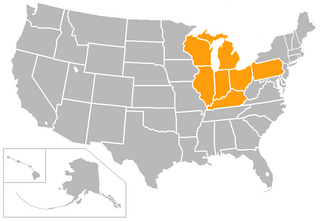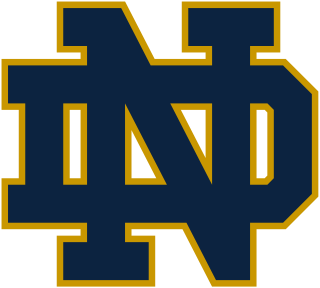Hoosier hysteria is the state of excitement surrounding basketball in Indiana or, more specifically, the Indiana high school basketball tournament. The most famous example occurred in 1954, when Milan defeated Muncie Central to win the state title.

The Horizon League is a collegiate athletic conference in the National Collegiate Athletic Association (NCAA) Division I. Headquartered in Indianapolis, the league's eleven member schools are located in and near the Great Lakes region.

The Purdue Boilermakers are the official intercollegiate athletics teams representing Purdue University, located in West Lafayette, Indiana. As is common with athletic nicknames, the Boilermakers nickname is also used as colloquial designation of Purdue's students and alumni at large. The nickname is often shortened to "Boilers" by fans.

Ross–Ade Stadium is a stadium in West Lafayette, Indiana, on the campus of Purdue University. It is the home field of Purdue Boilermakers football.

Big Bertha is a bass drum used by the Longhorn Band of The University of Texas at Austin. The Big Bertha name was chosen to evoke the famous German Big Bertha howitzer and has been used for two Texas bass drums, with the second debuting in 2022. Both Big Berthas have laid claim to being the largest bass drum in the world.

The University of Texas Longhorn Band (LHB), also known as the Showband of the Southwest, is the marching band of The University of Texas at Austin. The Longhorn Band was founded in 1900 by distinguished professor of chemistry, Dr. Eugene P. Schoch. The band is currently under the direction of Dr. Cliff Croomes. The band performs at all in-state football games, for various Texas Longhorn Athletics teams, and at special pep rallies and parades throughout the year. The band includes about 375 students, all of whom must register for a year-round course offered by the Sarah and Ernest Butler School of Music Butler School of Music .

The Harvard University Band (HUB) is the official student band of Harvard University. The Harvard Wind Ensemble, the Harvard Summer Pops Band, and the Harvard Jazz Bands also fall under the umbrella organization of HUB. Currently, the band plays for all football games as well as home men's and women's ice hockey games. Occasionally it plays at men's and women's basketball games. The uniform for both football games and other formal appearances consists of a crimson wool HUB blazer worn over a white shirt with a black HUB logo tie, black pants, and black shoes. In the early days of the Band, white sailor hats and khaki pants were worn. For hockey games, the band wears a custom Harvard Band hockey jersey, modeled after the home jerseys for men's hockey, which features images of Bertha on the sleeves. Band alumni, known as crusties, maintain strong ties to the HUB, sometimes continuing to act as regular members well after graduating from the university. Illegitimum non carborundum (INC) is the HUB motto. Written correspondence from HUB or HUB members is frequently signed with INC.

The Purdue "All-American" Marching Band is the marching band of Purdue University and performs at Purdue Boilermakers football games. The AAMB is also the official band of the Indianapolis 500 race, having held the position since 1919.

The Purdue Boilermakers football team represents Purdue University in the NCAA Football Bowl Subdivision (FBS) of college football. Purdue plays its home games at Ross–Ade Stadium on the campus of Purdue University in West Lafayette, Indiana. The head coach of Purdue is Ryan Walters, the 37th head coach in Purdue history. The Boilermakers compete in the Big Ten Conference as a member of the West Division. Purdue had most recently been a part of the Leaders Division of the Big Ten, but moved to the West Division in 2014 due to conference expansion.
The 1967 NCAA University Division football season was the last one in which college football's champion was crowned before the bowl games. During the 20th century, the NCAA had no playoff for the major college football teams in the University Division, later known as Division I-A and now as the Division I Football Bowl Subdivision (FBS).
The 1929 college football season saw a number of unbeaten and untied teams. Purdue, Tulane, Notre Dame, and Pittsburgh all finished the regular season with wins over all their opponents. Notre Dame was recognized as national champion by two of three contemporary major selectors, while the third (Houlgate) named USC (10–2). Eight of nine retrospective selectors later also named Notre Dame and USC as No. 1 teams.

The 2008 Purdue Boilermakers football team represented Purdue University in the Big Ten Conference during the 2008 NCAA Division I FBS football season. Joe Tiller, in his 12th and final season at Purdue, was the team's head coach. The Boilermakers' home games were played at Ross–Ade Stadium in West Lafayette, Indiana. They posted a 4–8 record, finishing in a ninth place tie in the Big Ten.

The 1977 Notre Dame Fighting Irish football team represented the University of Notre Dame during the 1977 NCAA Division I football season. The Irish, coached by Dan Devine, ended the season with 11 wins and one loss, winning the national championship. The Fighting Irish won the title by defeating the previously unbeaten and No. 1 ranked Texas Longhorns in the Cotton Bowl Classic by a score of a 38–10. The 1977 squad became the tenth Irish team to win the national title and were led by All-Americans Ken MacAfee, Ross Browner, Luther Bradley, and Bob Golic. Junior Joe Montana, a future Pro Football Hall of Famer, was the team's starting quarterback.

The University of Chicago Band is a pep band and a marching band for the University of Chicago. The Band was founded in 1898, five years after the university opened.
The 1984 Purdue Boilermakers football team represented Purdue University during the 1984 Big Ten Conference football season. Led by third-year head coach Leon Burtnett, the Boilermakers compiled an overall record of 7–5 with a mark of 6–3 in conference play, tying for second place in the Big Ten. Purdue was invited to the Peach Bowl, where the Boilermakers lost to Virginia. The team played home games at Ross–Ade Stadium in West Lafayette, Indiana. The Boilermakers defeated Notre Dame, Ohio State, and Michigan in the same season for the first time in college football history.
The 1964 Big Ten Conference football season was the 69th season of college football played by the member schools of the Big Ten Conference and was a part of the 1964 NCAA University Division football season.
The 1948 Big Nine Conference football season was the 53rd season of college football played by the member schools of the Big Nine Conference and was a part of the 1948 college football season.
The 1938 Big Ten Conference football season was the 43rd season of college football played by the member schools of the Big Ten Conference and was a part of the 1938 college football season.
The 2022–23 Penn State Nittany Lions basketball team represented Pennsylvania State University in the 2022–23 NCAA Division I men's basketball season. They were led by second-year head coach Micah Shrewsberry and played their home games at the Bryce Jordan Center in University Park, Pennsylvania as members of the Big Ten Conference. They finished the season 23–13, 10–10 in Big Ten play to finish in a tie for ninth place. They defeated Illinois, Northwestern, and Indiana to advance to the championship game of the Big Ten tournament. There they lost to Purdue. They received an at-large bid to the NCAA tournament for the first time since 2011 as the No. 10 seed in the Midwest region. They defeated Texas A&M in the first round of the tournament, marking their first tournament win since 2001, before losing to Texas in the second round.

The Leedy Manufacturing Company was an American manufacturer of percussion instruments headquartered in Indianapolis, Indiana. Leedy was highly successful in the early twentieth century, and was at one point the largest manufacturer of drums and other percussion instruments in the world.










